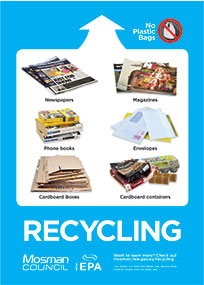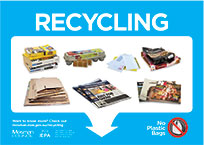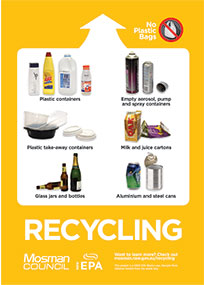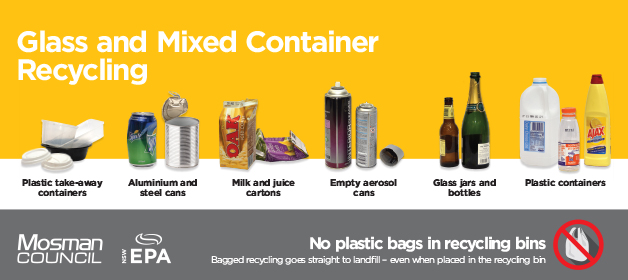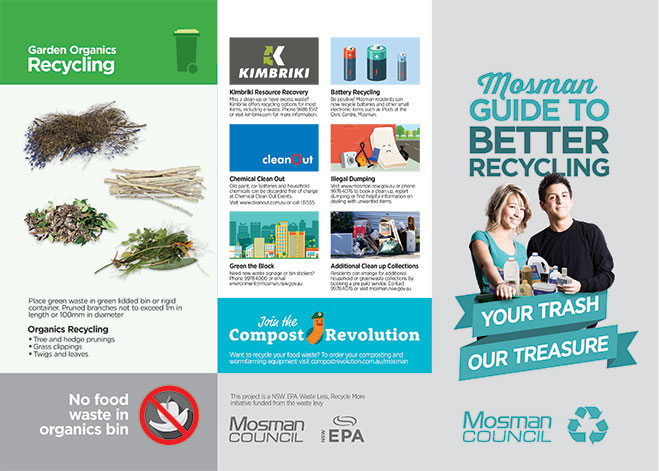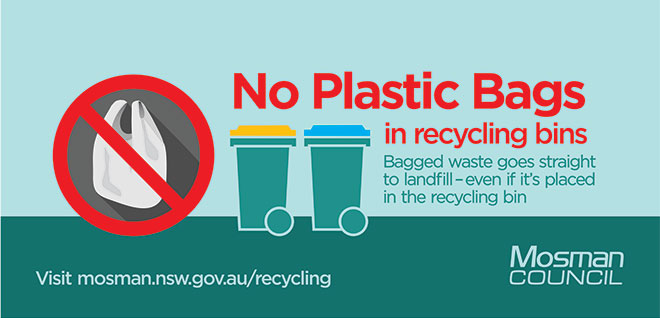Household Recycling
Council provides a weekly kerbside recycling collection service. Recycle your paper, cans, cartons and bottles.
Houses
| Service | Collection Frequency | Bin Type & Size |
|---|---|---|
| Glass & containers | Fortnightly, alternate weeks collection dates |
140 litre yellow lidded bin |
| Paper & cardboard | Fortnightly, alternate weeks collection dates |
140 litre blue lidded bin |
Units – Shared Bins
| Service | Collection Frequency | Bin Type & Size |
|---|---|---|
| Glass & containers | Weekly collection dates |
240 litre yellow lidded bin or 55 litre red crate |
| Paper & cardboard | Weekly collection dates |
240 litre blue lidded bin or 55 litre green crate |
Customer Requests and Additional Services
Report a missed service or lost or damaged bin
Please call Council’s Waste Line on 9978 4076.
Request a new recycling bin or change of service
Please contact Council if you wish to discuss recycling bin needs on 9978 4000.
What Recyclable Material is Collected?
Yellow lidded bin – plastic and glass containers
| Accepted in this bin | Not accepted in this bin |
|---|---|
|
|
Blue lidded bin – paper and cardboard
| Accepted in this bin | Not accepted in this bin |
|---|---|
Crush and flatten all cardboard boxes and place loosely in the bin. |
|
Recent studies indicate that the average Mosman resident garbage bin still contains up to 28% recyclables, items that should have been recycled! See our A-Z of waste disposal to reduce your waste to landfill.
Frequently Asked Questions

Are pizza boxes recyclable?
Clean pizza boxes (e.g. not too much grease and no food) can definitely be recycled in the blue lidded bin. In addition, please remember to flatten any cardboard that is placed in the bin. If the cardboard is jammed in it makes it hard for the contractor to empty the bin.
Which recycling bin do I place milk and juice cartons in?
Milk and juice cartons are placed in the yellow lidded bin for containers, glass and plastic.
Milk and juice cartons are made from a product known as liquidpaperboard (LPB), which is not ordinary cardboard. It is made from a layer of cardboard sandwiched between layers of plastic. Some LPB cartons also have an aluminium layer. A special technique is therefore needed to separate each layer for recycling and this is why milk and juice cartons are placed in the yellow lidded bin for recycling as opposed to the blue lidded bin for paper and cardboard.
What plastic can be recycled?
Not all plastics can be recycled, such as plastic wrap or plastic bags. The recycling service accepts most types of plastic containers, including but not limited to bottles marked 1 to 7:

For example, if you look on the bottom of a plastic milk bottle you will find the symbol ‘1’ or ‘2’. This plastic container can be recycled in your yellow lidded bin.
The numbers 1 to 7 indicate what kind of plastic the bottle/container is made from and what kind of product the bottle/container can be made into when recycled. For example, plastic bottles marked with the number 1 – such as a soft drink or water bottle – are made from PET (polyethylene) and can be made into more soft drink bottles and even fleecy jackets.
How do I present my bins for collection at the kerb?
- All waste and recycling bins must be placed directly outside your property, at the kerb, the night before your scheduled service, and clear of any impediments such as trees and telegraph poles. This is to ensure that your bins are able to be serviced. The service times may vary throughout the day of your collection, therefore bins placed out on the morning of your collection day may be missed.
- Please ensure that the lids of your bins are fully closed when they are presented for collection. Items placed next to bins will not be collected. Overfull bins create litter and pollution in our streets and waterways, so let’s work together to keep Mosman streets clean!
- Bins, once serviced, must be collected as soon as possible and stored back on the property to which they belong.
Why is it important to reduce, reuse and recycle?
Reducing, reusing and recycling waste is considered to play an important role in tackling climate change. General household waste that goes to landfill is a major contributor to global warming and climate change. Methane, a greenhouse gas 21 times more damaging to the environment than Carbon Dioxide, is emitted as a result of waste breaking down in landfills. Recycling reduces the amount of waste going to landfill, delivers significant energy and water savings, conserves non-renewable virgin resources and reduces greenhouse gas emissions.
Recycling helps to reduce the size of your garbage bin and saves you money! The Domestic Waste Charge is based on the principles of “user pays” where the amount charged is determined by the size of the garbage bin and the frequency of service to each residential property. The smaller the garbage bin, the less waste to landfill and the lower the rate charged.
The cost of waste to landfill is increasing. The NSW State Government, under the Waste Avoidance and Resource Recovery Act 2001, has developed frameworks and policies for reducing waste and making better use of our resources, such as the NSW Waste Avoidance and Resource Recovery Strategy 2014–21. Under this Strategy, by 2014 local government, industry and the community must work towards raising the amount of waste being diverted from landfill from the current 26 per cent to 66 per cent. In order to ensure this target is met the NSW State Government has increased the cost of sending waste to landfill.
Waste Resources
Our work shows that residents need more information about recycling in Mosman. In an effort to improve recycling outcomes, we have created new signage and educational material to make sure residents know exactly what is recyclable, and what should be placed in the landfill bin. Check out the printable resources below (click on image to download file).
No printer? These materials are available to residents free of charge. Pop in to Council or call 9978 4000 today to get hold of these great resources, and start recycling right today!
